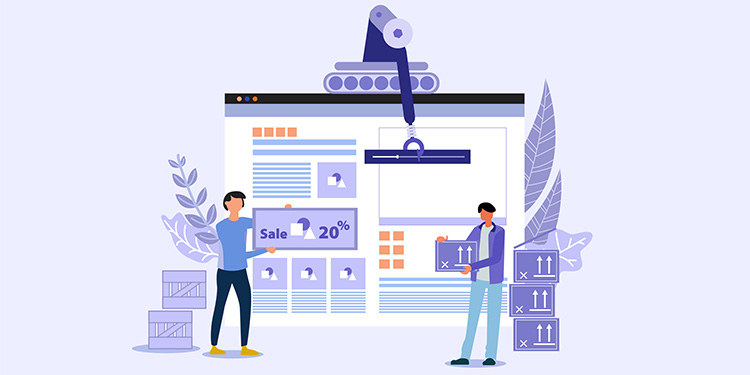Are you a small to medium-sized business looking to boost your online sales? With more and more consumers turning to the Internet for their shopping needs, having a strong e-commerce website is essential.
But how do you optimize your website to drive conversions and achieve growth?
In this article, we’ll explore effective strategies that will help you create a user-friendly website that maximizes conversions.
Optimize your Homepage
Your homepage is the virtual storefront of your online business. Optimizing it is crucial to make a lasting impression and encourage conversions.
Strategically place clear and prominent CTAs that guide visitors toward desired actions. Whether it’s making a purchase, signing up for a newsletter, or exploring further, compelling CTAs encourage conversions.
Ensuring your homepage is mobile-friendly, responsive, and provides streamlined mobile navigation is also key in today’s mobile-first landscape. Display your contact information visibly to establish trust and to make it easy for potential customers to reach out to you.
But it isn’t just about the technical aspects of your homepage. Tailoring your homepage content and product recommendations based on user preferences can create a personalized shopping experience. This help to increase the likelihood of a purchase.
In an age where online security is paramount, reassure your customers of your care for their online safety. Prominently display trust symbols, SSL certificates, and secure payment options. This builds trust and instills confidence in potential buyers.
Analyze your Analytics
Understanding your website analytics is vital for identifying areas where visitors may encounter obstacles and optimizing their path to purchase. Utilizing tools like Google Analytics can provide insights into user behavior, bounce rates, time spent on site, and conversion funnels.
Identify pages or steps in the conversion process where users drop off or show hesitation. This can help reduce friction and increase conversions. Simplifying the checkout process, minimizing form fields, and offering guest checkout options can also streamline the purchasing experience.
Improve your Website Speed
A slow-loading website can deter potential customers and harm your conversion rates. To enhance website speed, compress images without compromising quality to reduce file sizes and improve load times. Leveraging browser caching to store website data on visitors’ devices can reduce the need to reload content with each visit.
You can also reduce the number of elements on your web pages that require separate server requests. Keeping your CSS and JavaScript files as simple and trimmed down as possible will help.
Further, improve website speed by utilizing a content delivery network (CDN) to distribute your website’s content across multiple servers globally.
Convey your Unique Selling Proposition
Your Unique Selling Proposition (USP) differentiates you from competitors. Make sure it is clear and visible on your website. You can do this by developing a concise and impactful headline that conveys your USP and captures visitors’ attention.
Communicate the unique benefits customers will experience when they choose your products or services. This can be done by featuring customer testimonials or success stories that highlight how your offerings have positively impacted others. Using high-quality visual aids can further set your e-commerce business apart from the rest.
Build Trust in your Customers
Building trust is essential for encouraging visitors to make a purchase.
Showcase genuine customer reviews and testimonials prominently on your website. Display trust badges from recognized security providers. Providing a variety of secure payment options can also help instill confidence in potential customers.
Use “Charm Pricing”
Charm pricing, also known as psychological pricing, involves pricing products with numbers that end in 9. For example, $19.99 instead of $20. This pricing strategy has been shown to influence consumer perception and increase conversions.
The visual appeal and the perception of a lower price can make potential customers more likely to buy.
When implementing charm pricing, ensure that the discounted prices are genuine and not misleading. The strategy should be used responsibly to build trust with customers.
Simplify the User Experience
Making sure your site is simple to use is critical in making sure your customers are enjoying their shopping experience.
By optimizing page load speed you will be able to drive even more purchases on your site. You can also optimize your website for mobile users (creating a website design that adapts to different screen sizes and resolutions). Creating a simple and easy-to-use navigation menu will also help make your website as user-friendly as possible.
Provide a user-friendly and intuitive experience by organizing categories and subcategories logically. Including a prominently placed search bar, using descriptive labels, and minimizing clicks to reach desired pages.
Optimize Product Pages
Optimize your product pages by including high-quality images, detailed product descriptions, customer reviews, and clear CTAs. These additions will further enhance your potential customers’ shopping experience.
Above all, make conversions a priority in your e-commerce website optimization efforts. Regularly analyze your website performance, test new strategies, and adapt based on data-driven insights. Continuously monitor and refine your website to improve the user experience, build trust, and ultimately drive more conversions.
By implementing these strategies, you can create a user-friendly and persuasive website that maximizes conversions. Remember to prioritize conversions and continuously optimize your website to stay ahead in the competitive e-commerce landscape. With a little effort and attention to detail, you can increase your online sales and achieve your business goals!



